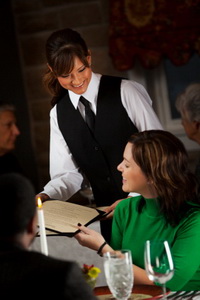I’d tell you where this happened, but I don’t want to blacken the reputation of an entire nation. I was travelling abroad on a magazine assignment and dining in the four-star restaurant of my hotel.
I decided to treat myself to a special wine that I had first tasted just three weeks earlier … the memory of its smoky cassis aromas still lingered. So what if it cost $150 for a half bottle?
So I summoned the sommelier. Unlike his confrères—the maître d’, the head waiter and a junior waiter who had brought me bread and water with civility—this functionary was a dour gentleman. He took my order with no pleasure and looking slightly miffed, brought me the bottle. (Had I ordered the last bottle, which he was planning to serve to a favourite patron?) As he waited for me to try the wine, he tapped his index finger on the bottle—waiter code for “Hurry the hell up, I’ve got larger groups to serve, for better tips.”
Intimidated, I quickly swirled and sniffed—and realized that the wine was corked. Those aromas I remembered with such pleasure had been pulverized by the telltale smell of moldy damp cardboard. My stomach dropped to my feet and I wanted to crawl under the table. To buy time, I swirled and sniffed some more, as the sommelier looked ready to throttle me.
The simple words “I’m sorry, but this wine is corked” formed on my lips, then died there. This may seem odd for someone who writes about wine and has consumed something equal to the annual production of several former Eastern Bloc countries, but I just couldn’t do it. I grimaced and said the wine was fine; and with a parting glare, the sommelier trotted off.

As I sat choking down sips of my $150 liquid cardboard, I started to get angry with myself, the sommelier, the restaurant management and the cork industry. In the sommelier’s mind, I was probably already a loser for dining on my own, as well as a complainer for having asked to switch tables when the group beside me started smoking. Now I was about to reveal myself as a freeloader too, for drinking a whole glass of wine before sending the bottle back.
By the time he returned to refill my glass, I was trembling with rage and nerves. I couldn’t face issuing a direct order. Instead, I suggested quietly that the wine might be off and asked that he try it. His narrowed eyes squished me from six inches to three as he whisked away my bottle to his tasting table with a flourish that a grand marshal would have admired. By that time, other diners were watching with interest. He poured a small amount, sniffed at it briefly, then returned to my table with it.
“It’s fine,” he said curtly and strode off.
I stared at his departing back with my mouth open. The message was clear: shut up and drink it.  The confidence I’d built up over five years of writing about wine and tasting thousands of samples vanished. I knew I was right, but I felt shattered. I couldn’t even imagine what such a situation must be like for someone who isn’t knowledgeable about wine. That’s why so few restaurant patrons dare to assert themselves.
The confidence I’d built up over five years of writing about wine and tasting thousands of samples vanished. I knew I was right, but I felt shattered. I couldn’t even imagine what such a situation must be like for someone who isn’t knowledgeable about wine. That’s why so few restaurant patrons dare to assert themselves.
According to the sommeliers I asked, less than 1 percent of all bottles are ever sent back. But industry statistics estimate that 5 to 10 percent of bottles are corked or otherwise flawed. Clearly, something is wrong here. The problem, of course, is that most people feel too uncertain about their wine judgment to insist and don’t want to ruin what should be a pleasant evening out with a confrontation with the sommelier.
But I was certain that I had a bad bottle. And after staring at my corky wine for a while, I asked the maître d’ to bring the manager—a pleasant woman in her forties. Walking out with her into the quiet lobby, I explained the situation. Fortunately, instead of dismissing my complaint, she was mortified. In fact, she was so empathetic that I burst into tears.
The more she tried to calm me, the harder I cried. My crust of fear and anger had been gently peeled away to expose my shame. Who knew that rejecting a bottle of wine involved the same arc of emotions as Greek tragedy?
The manager was as efficient as she was understanding. Within a few minutes I was back in my room, tears dried and dinner served to me privately, with a full bottle of the great wine—as pleasurable as I remembered it, but now with an added layer of comfort.
So that was a happy ending, but it did get me thinking about how the situation should have played out. In fact, the correct procedure for a diner is what I did—except that it only works with staff who don’t derive sadistic satisfaction from humiliating guests.
If you smell and sip the wine and believe it may be off, tell the sommelier and ask him to try it. Whether he agrees or not, a well-trained server or sommelier will take the bottle back anyway, with no arguing or huffing. (And if the sommelier thinks the wine is just fine, he should never share his opinion and turn the diner into a puddle of neuroses.)
Sometimes servers are less malicious than ignorant. I once told such an eager fellow that my wine was corked. He held my bottle up the light, said he couldn’t see any floaty bits in it, but he’d be happy to run it through a sieve for me. I told him kindly but firmly that the wine had gone bad and he should bring me another bottle free of charge.
Many scrupulous people feel guilty about sending back a bottle because they believe the restaurant (or server) will suffer for it financially. But an establishment can usually return rejects to the wine merchant for full credit. Remember, too, that restaurants take the cost of returned bottles into account when they price their wines, which means that anytime you buy a bottle, you’re already paying for the privilege of being able to send it back.
You might think that a restaurant’s no-questions-asked return policy would leave it vulnerable to exploitation by either calculating cheapskates or by wine bores who reject perfectly good wines merely to show off. Fortunately, such incidents are rare. In fact, those sommeliers I asked said the opposite is far more often the case: the wine is actually bad but the customer (who really knows little about wine) rhapsodizes about it.
What happens, though, if a wine isn’t technically faulty, it’s just poorly made or lacking in character? No one should have to drink wine he or she doesn’t like, but the situation is delicate. If the sommelier or waiter recommended the wine, there should be no problem sending it back. But if the diner chose it himself, it could be argued that he’s responsible for his choice and should pay for that bottle even if he orders a replacement. Others, including me, believe that if a wine is on the list, then the restaurant implicitly endorses it and should replace your bottle free of charge if you’re not satisfied.
An even more complicated scenario: what if the wine is actually good, of its kind, but the customer just doesn’t like the style? Again, if staff suggested it, they should take responsibility. If servers are going to recommend wines at all, they should ask enough questions to determine the diner’s preferences in terms of body, sweetness and flavor; and they should describe the wine fully so the diner has some idea what he’s getting, including whether the wine will complement his meal.
A good sommelier should also be aware that many people are wine novices and adjust her recommendations accordingly. This is especially important with expensive wines: some neophytes
believe that if a wine costs a lot, they’re guaranteed to love it—which isn’t necessarily the case. If a novice rejects a pricey wine because it smells of sweaty saddles and cigar boxes, all the sommelier can do is gently explain that this is the nature of that wine.
Should she, however, exchange it free of charge for another more suited to the diner’s taste? Isn’t that leaving the restaurant on the hook for customers’ poor decisions?
Some restaurants have a policy of refusing to take back certain wines if they’re not faulty: bottles over twenty-five years old, for example, or ones that cost more than $300.
If such a policy is in place, it should always be noted on the wine list. The sommelier should always mention it to customers contemplating ordering such a bottle.
A restaurant doesn’t necessarily lose money on returned wines. Ones that are in fact good can be sold by the glass or offered to staff for tastings and education. (Those party noises coming from the kitchen? The rich twit at the next table just sent back the Latour.) Savvy restaurateurs often offer a complimentary glass of wine to regular customers as a perk.
Join us on CTV’s The Social August 30 when we’ll play out real-life restaurant sticky wine situations like sending back the bottle and others. It’ll be fun!











